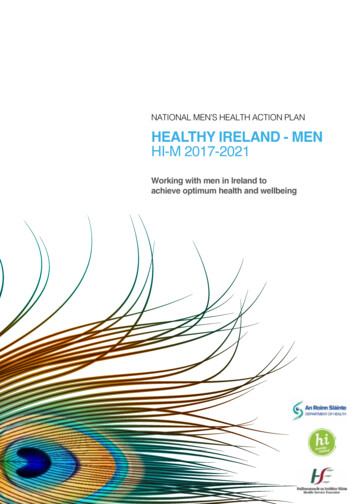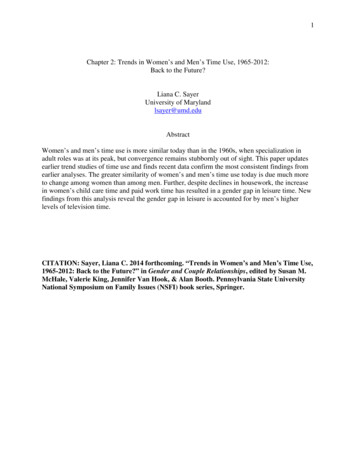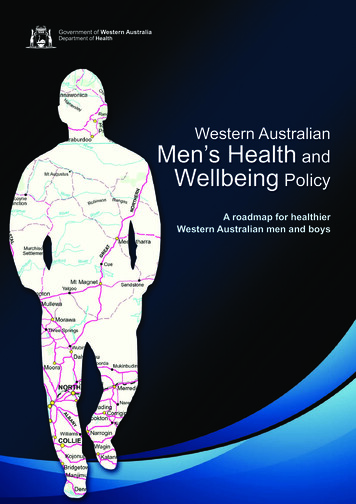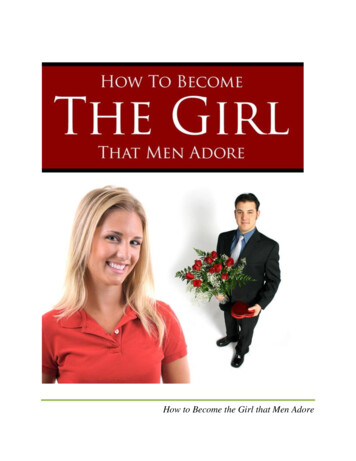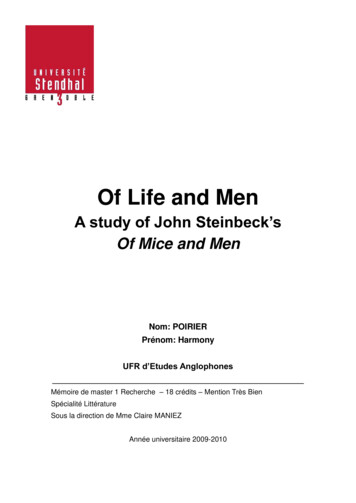
Transcription
Of Life and MenA study of John Steinbeck’sOf Mice and MenNom: POIRIERPrénom: HarmonyUFR d’Etudes AnglophonesMémoire de master 1 Recherche – 18 crédits – Mention Très BienSpécialité LittératureSous la direction de Mme Claire MANIEZAnnée universitaire 2009-2010
AcknowledgementsTo Mrs Claire Maniez, for accepting to supervise my work and for her availability allover the year,Marion Gadras for her proofreading and her judicious remarks,Mickaël Bouvier, Adeline Bouvier, Stéphanie Merley and Isis Zidan for their supportand their advice.
3Table of contentsTable of contents . 3Introduction . 4I- The founder myths of Of Mice and Men, the ‘ancestors’ of the Bildungsroman . 81) The influence of Christianity: the Bible. 92) The influence of the Arthurian legends: the quest for the Holy Grail. . 18II- Characterization: a path towards progression and self-improvement. . 301) Lennie, the embodiment of George as a child. . 312) Of Mice and Men: the story of George’s evolution. . 363) The figure of the Guide: Slim. 43III- The end of the initiation . 501) The end: towards a new beginning? . 512) Steinbeck’s dystopia . 553) From realism to a new utopian vision of man? . 64Conclusion . 70Bibliography . 73Appendix 1 . 76
4IntroductionJohn Steinbeck‟s Of Mice and Men is a classic in American literature, studiedeach year by hundreds of pupils. It was written in 1937, telling the tragic story of Lennie Small and George Milton, two migrant workers in California during the Great Depression. It is one of the three novels composing what critics have called the „Californian cycle‟, along with In Dubious Battle and The Grapes of Wrath. These novels have incommon to give a voice to the Californian working class of the thirties. These peoplewere struggling to survive the Great Depression when their lands were being seized andhundreds of them found themselves on the roads moving to a faraway place where theywould find jobs or wandering from ranches to ranches, offering their help.Critics soon classified Steinbeck into the new movement of writers who took upsome Marxist and more generally socialist ideas or ideals in their novels. However,Steinbeck was not a member of the communist party and even declared to his agents ina letter that he thought there were as many communisms as communists (Astre, 1977).Of Mice and Men is thus more than a mere pamphlet protesting about the life conditionsof the migrant workers. His good knowledge of these men‟s life and language providedhis novel with a wider dimension: the story can be assimilated to that of persecuted minorities or silent people whose sufferance goes on unnoticed.Steinbeck originally gave his book the title Something That Happened. However,he changed it into Of Mice and Men after he read Robert Burn‟s poem To A Mouse (seeAppendix 1), a poem telling the lamentations of a farmer who destroyed a mice‟s nestwhile plowing his field and his thoughts on life this event inspires him. This poem thusdeals with the themes of life‟s unkept promises and mice‟s ability to enjoy the presentwithout fearing the future, contrary to men. Indeed, the novel is about failed dreams,lost hopes and loneliness, but also about learning how to give up, how to grow up andhow to adapt. Steinbeck‟s change of title therefore reveals the brevity of life and its relative lack of importance when compared with the whole history of mankind but also thesimilarities between a mouse‟s life and that of a human, both struggling to keep theirhouses and to stay alive as long as possible. Of Mice and Men is thus the story of one of
5these banal lives, which is nothing but a mere drop in the ocean of lives but which yetbrings something new and allows mankind to evolve, as it has always been, just becauseof this one more fight for survival. However, the Scottish poet Robert Burns‟ entireverse suggests the somewhat pathetic aspect of this eternal struggle for a little bit oftime bonus on Earth: “the best led schemes o‟ mice an‟ men gang aft agley”. The ironyresides in the fact that despite the smallness of their lives, both men and mice keep making plans to secure the future, which are inevitably destroyed like a nest or a farm. Thisnote of sarcasm reaches its high peak at the end of Steinbeck‟s novel with Lennie‟sdeath and the destruction of the edenic dream at the same time.This dream is at the core of the novel, for it stands for these doomed plans menkeep making about the future. They embody both men‟s highest hopes and secretdreams but also represent the pathetic dimension there is in making such plans out offear for the future, the unknown. All the living species appears to be creatures livingperpetually on guards, go to work every day for their dreams to come true and whenthese are destroyed, they build other plans, without wondering why their dreams did notbecame real. The original American dream is one of these utopian dreams, come out ofthe brain of some persecuted people who dreamt of a pure and peaceful life on a newcontinent. However, this dream evolved and transformed into an exploiting society toobusy at realizing more and more profits than caring about its citizens‟ expectations.Steinbeck deplores this society claiming to be favoring progress and evolution by introducing the reader to the world of itinerant workers, still victims of racism, old age ostracism and mental illness discrimination. Such a world does not keep the characters fromdreaming of a farm with a couple of acres and a few rabbits, even when they meet otherdreamers, disillusioned ones. Curley‟s wife and her Hollywood dream of becoming anactress although she comes from a small town in a Californian valley, Crooks and hisdream of equality between black and white or even Candy and his hope about his olddays he wishes to be peaceful, reflected by how he would have wanted his old dog todie are as many doomed dreams, almost naive. Steinbeck‟s critics have seen in thisdream some nostalgia of the old golden days of the discovery of the American continentand declared the end of the novel the evidence of Steinbeck‟s pessimistic view of thefuture of this society.The purpose of our study is to attenuate the pessimistic reputation this novel car-
6ries to reveal its strong positive message, even though its general tone tends to justify itsreputation. In fact, Steinbeck‟s influences give it a formative dimension through the lifelesson taught by its hero, George. The reader undergoes the same progression Georgegoes through during the three days this short novel lasts, three days which are not without reminding the reader of another three days, the time it took to Christ to prove hisfollowers they had not believed in him in vain.In fact, the Bible is one of Steinbeck‟s major influence, the second being of morepagan descent; the Arthurian legends. Indeed, Steinbeck tackles ancient questions whichhave already been asked and developed in myths in an attempt to explain them. Fate isone of these: the issue of hereditary sins, the impact of our forbears‟ acts or missed opportunities in our lives appear in Steinbeck‟s novel as in the two major founding literaryworks of Western literature. This idea of fate is particularly present in the Bible, whosetwo testaments tend to divide the massive collection of books into two parts, the story ofJesus and that of his ancestors. In fact, the Bible not only bears the mythical responsibility of explaining the origins but it also tells the story of mankind and its failures. Theteaching aspect lies in this revelation of men‟s actual condition and the mistakes madeby their ancestors which determined their fate. However, the process of this biblicalredemption is developed by the Arthurian references. These are not new in Steinbeck‟snovels: Tortilla Flat, written two years before Of Mice and Men openly draws parallelsbetween these men‟s quest and that of the knights of Camelot. Moreover, Steinbeck‟slast work was the rewriting of Malory‟s Morte d’Arthur, which his death has left incomplete. The quest for the Holy Grail and the tests needed to be surmounted inspiredSteinbeck and it is visible in Of Mice and Men. Steinbeck illustrates in his novel thedifferent causes which triggered the failure of Lancelot or Adam, and stresses the factthat the new generation has the role and the duty to learn from these mistakes in ordernot to commit them again, hence the formative aspect of the novel.In order to develop this point, we will take a close look at characterization, andthe various roles assumed by Steinbeck‟s ranchers. Lennie is a paradox, for he is a childin a giant‟s body, does not possess an ounce of nastiness but cannot help killing miceand frightening girls when petting their soft manes, is a dreamer who hates violence butalmost destroys Curley‟s hand when told by George to defend himself. A victim of hisown strength and ignorant of how to handle it, as a child who would have grown up too
7fast, he completely relies on George to take care of him. This one appears disappointedby his life and keeps complaining about how difficult it is to be responsible for Lennie‟sacts. George appears rather mysterious, for he curses his current life but shares Lennie‟sdream, among other things. It seems to the reader that there is a discontinuity betweenwhat he thinks and what he would like to be doing. This divided state of mind needs tobe solved in order for George to find peace so he can be „complete‟. Slim plays an important role as well: in fact, this character immediately appears to the reader as a royalfigure. A progression is visible in George as soon as he talks to Slim, and as Georgelearns from Slim‟s wise answers, the reader learns about the complexity of this character. Slim is a major piece in George‟s progression, for he guides him in the hard apprenticeship of life, thus bearing strong similarities with the formers of novice during theinitiation rites in some tribes.Finally we will examine Steinbeck‟s vision of the kind of plans men need tomake so these projects can be realized. George is his creation, the model he founded inorder to make the reader realize the paradox of his species: master of all the species onEarth but who still does the same thing as a little mouse whose nest has just been destroyed, rebuild it somewhere else. Our aim is to draw attention to what Steinbeck hadhimself in mind when he wrote the novel, for he changed the title. Life is not just something that happens, but a succession of small acts for survival. In that extent, Steinbeck,witness of the changes the society he lived in was going through, chose to offer his solution to humanity‟s endless quest for mastering: mastering death, God(s), the unknown,the future. This is this solution we are going to study and George‟s progression to cometo it, for the reader undergoes the same initiation.
8Part 1The founder myths of Of Mice and Men, the ‘ancestors’of the Bildungsromane
91) The influence of Christianity: the Bible.Steinbeck is an occidental writer; he was born in a country whose history isclosely linked to Christianity and thus carries an important unconscious religiousbackground which influences his writing. Therefore, it is essential to have a look at thebiblical references in Of Mice and Men, their significances, and the consequences on thereading of the novel. For this purpose, Gérard Genette‟s works on transtextuality (1982)cannot be ignored. He developed the term from Julia Kristeva‟s intertextuality, insertingit into what he thought to be a wider category, transtextuality. He classified the latterinto five subtypes in Palimpsestes: intertextuality, paratextuality, metatextuality,architextuality and hypertextuality. Genette defines the latter as what he calls : “touterelation unissant un texte B (que j‟appellerais hypertexte) à un texte antérieur A (quej‟appellerais, bien sûr, hypotexte) sur lequel il se greffe d‟une manière qui n‟est pascelle du commentaire” (7). Here, this hypotext would be the Bible. As for the hypertext– thus a text linked to the hypotext by its themes, symbols and recurrent references –one may justifiably object that Of Mice and Men is not Steinbeck‟s novel whichcontains the most significant biblical references; in fact, The Grapes of Wrath (1939)happens to be a novel strongly and blatantly linked to the Bible, whose characters arebiblical characters and whose plot reminds the reader of the Exodus. However, Of Miceand Men was written in 1937 between an Arthurian novel, Tortilla Flat (1935), and abiblical one (Steinbeck and Wallsten 1975, 96). It thus unites in the same book both ofSteinbeck‟s major influences; the Arthurian legends and the Bible. We will focus on thelatter for this part.The Bible appears to be a major literary influence in the Christianized part of theworld, most of the time unconscious and unintended by the writers. However, we thinkit is important to clarify some essential points: the Bible is to be looked at from aliterary aspect, there will be no religious questions debated ‒ in the sense of faith andbelief ‒, the issue of the literarity of the Bible and its influence on the literaryproduction since then, all potential hypertexts, will be the only aspect studied.The question of the literarity of the Bible has been debated – and still is – among criticsbut its strong influence upon literature is no longer to be contested. Olivier Millet evenasserts in his introduction to his collected essays on the Bible and literature that it is one
10of the three major sources of the Western culture, along with the Greco-Latin cultureand the Celtic inheritance (8). It can thus be considered as the hypotext ‒ in the wordsof Genette ‒ of numerous literary productions, and we will see that Of Mice and Men isnot an exception: the biblical occurrences are ever-present all over the novel.First of all, a global study reveals a cyclical structure. At the beginning, the twomain characters, Lennie and George, stop by the Salinas River down the road, and thelast scene takes place at the same spot. Nature is thus given an important place, for thestory starts and ends in an entirely vegetal and animal environment, where no one is tobe found except Lennie and George. This is the first similarity with the Bible, whichalso has a cyclical structure through the theme of Christ‟s rebirth. Northrop Frye dealtwith the subject of cycle in the Bible in his Great Code, mentioning that even thoughthe Bible is reluctant to admit any influence of anything pagan or assimilated to paganbeliefs, some books were written assimilating “Jesus to the revolving cycle of nature”(96), for the parallel is too obvious not to be pointed out. In fact, Christ‟s death andrebirth seem similar to the evolution of the natural elements throughout the year.Moreover, the original paradise is a garden where nature is a synonym for apeaceful and innocent happiness, in osmosis with the very first human beings, a “retreatfrom the world to a primeval innocence” as Peter Lisca calls it (134). The sameatmosphere is to be found at the beginning of Of Mice and Men, where the naturallandscape of the Salinas River banks is described with words such as “quietly”,“noiselessly” (4). Northrop Frye depicts the Garden of Eden as “an oasis imagery oftrees and water” (1982, 142): it could perfectly be the description of the beginning ofSteinbeck‟s novel. Indeed, trees and water are the setting of the cyclical structure of theBible and Of Mice and Men. They both refer to a safe and protected place, where thecodes and the way of living are different ‒ Adam and Eve start to feel ashamed of theirnudity at the moment they are expelled from the garden of Eden ‒ and in Steinbeck‟snovel, the place appears to be a shelter from the dangers of the outside world, almost aworld in the world: George tells Lennie “to come right here an‟ hide in the brush” ifanything goes wrong at the ranch (17). Trees and water strengthen the hypertextual linkwith the Bible, adding a symbolical meaning to the „safe oasis‟ aspect we just discussed:
11indeed, these two images of an edenic place are to be found in several passages of theBible.Water is a purifying image, bringing life and salvation: the numerous baptisms,the purging Flood, Moses creating a miraculous and vital spring in the desert are asmany proofs of the importance of water in a biblical context. The symbolicalimportance of water springs into focus when it is taken into account that the placesdescribed in the Bible are situated in an arid zone of the planet, and thus for itsinhabitants, water truly is „liquid gold‟. Besides, as mentioned by Northrop Frye, it waswater which was pouring out of Jesus‟ side when pierced by the Roman‟s spear in orderto complete Christ‟s execution (1982, 147). According to Robert de Boron, first writerto explicitly give a Christian explanation of the Holy Grail myth, this water was to becollected in a cup of gold by Joseph of Arimathea, cup which was to become the aim ofone of the most famous quest in literature and history, the quest of the Holy Grail(Walter 2004, 20).The vegetation is not to be left out, as there are many sorts of trees mentioned inthe Bible, among them the sycamore. This tree is known as the Egyptian fig tree or ficussycomorus and also illustrates the cyclical structure, for it is the symbol of rehabilitation‒ it produces new branches when it is cut, even totally buried into the sand. 1 These treeswere also wise men‟s and prophets‟ preaching place, and Zacchaeus climbed on asycamore in order to see Jesus‟ arrival. This is one of many references to down to up ‒and vice versa ‒ trips, and will be discussed later. Moreover, the sycamore is a populartree in California, and thus finds its place into Steinbeck‟s depiction of nature in OfMice and Men. Indeed, at the beginning of the novel, the characters find a quiet spotdown the road, near the river, where they will spend the night before going to the ranch:1It might look strange to the informed reader of the Bible to read here that the trees where wisdom was tobe heard were sycamores instead of fig trees. However, there were well and truly sycamores, only om/edo/index.php?option com content&view article&id 135:lesycomore-et-lhysope&catid 37:autres-text&Itemid 49. Feb 2010.
12The valley side of the river is lined with trees‒willows fresh and green with every spring,carrying in their lower leaf junctures the debris of the winter‟s flooding; and sycamores withmottled, white, recumbent limbs and branches that arch over the pool (3).Later on, the “limb of a giant sycamore” is mentioned as a place where men had madecampfires (4). This is the first description of nature, and it will remain the only one untilthe end, where the tranquility of the same place is depicted once again, emphasizing thedramatic atmosphere in this last scene. But the first biblical references about trees tocome to mind are indeed the tree of Life and the tree of Knowledge of Good and Evil inthe Book of Genesis. By eating the fruit of the latter, Adam and Eve lose the benefits ofthe former, which were to live forever in this state of innocence and peace. The circle iscomplete then, according to Frye (1982,147): “Adam and Eve, then, when they areexpelled from Eden, lose the tree and water of life, and at the very end of the Bible it isthe tree and water of life that are restored to redeemed mankind (Revelation 22,1-2)”.The cyclical nature of the Bible is thus to be found in its symbolical images, as in OfMice and Men, where nature is to be found at the beginning and at the end, bringingpeace and relief to the characters when they need it most, as a silent witness of men‟shectic lives.Trees also offer another perspective to the cyclic one, the vertical one. We havementioned Zacchaeus, a small man who climbed on a sycamore in order to be able tosee Jesus above the crowd. This is not the first occurrence of a vertical imagery in theBible, the most obvious one is Jacob‟s dream of the ladder in the Book of Genesis,which angels keep climbing up and down, revealing the existence of an upper world andlinks between this world and humans‟, and then a need to rise up to a superior level inorder to catch a glimpse of the divine. The cross upon which Jesus dies bears the samesignificance: this piece of wood sends the living divinity back to the upper level hecame from. Moreover, the cross has the symbolical meaning of meeting, intersection,union: the horizontal line represents the human and natural world whereas the verticalline embodies the divinity. Northrop Frye introduces the reader to the notion of axismundi in his passage about the tree of Life. He defines it as “a kind of axis mundi, thevertical perspective of the mythical universe, in which the earth is so often a middleearth between a world above and a world below” (1982, 149). The whole pastoralimagery in the Bible is thus associated with the divine, it links humans to the divinity:
13nature is a tool which is meant to help men to reach (back) to the upper world. Thisreinforces the literary aspect of the Bible, and more precisely its similarities to myths.It would be a misuse of language to classify the Bible as a literary productionaccording to Northrop Frye, though he carries on explaining that most of its elementsare written in a language specific to myths and metaphors (1990, 96). In fact, we haveseen that the Bible contains several pagan elements, like the natural elements we justdealt with, for early Christians needed to include some known themes and symbols to itin order to make it acceptable and identifiable to by the local populations still adoringpagan gods, most of them related to natural elements. Many biblical stories are adaptedfrom preexistent pagan myths, though throughout the Bible, pagans are being chased,punished, and their gods are proved to be inefficient.2 However, the will ‒ and the need‒ to set its authority as a religion and not as any belief or ritual was the strongest and theBible had to make „concessions‟ to gain people‟s hearts and minds. Thus, through theadaptation of pagan myths, the ritualizing of major Christian feasts and the spread of asacred and mystic aspect of a divinity one should respect and fear, the Bible starts tobear a resemblance to the same myths it wanted to replace and eradicate if possible.Mircea Eliade discusses the sacred aspect of the myth, which, according to him,comes from the fact myths tell the story of the origins (1963, 15). Therefore, myths alsonarrate the story of the one or those who created the actual world; god(s). This is acommon point with the Bible: the divine is everywhere, in every man‟s single events ofhis life, and thus is to be feared. This omnipresence of the divinity leads biblical ormythical characters to respect it and to follow its principles as a guide, out of fear forpossible punishment and praise for what God gave them. This last point leads us towonder what the aim of myths is. In fact, their formative aspect could be seen as anattempt to solve the everlasting mystery about how life came to earth, or a lesson onewould be well-advised to apply to his own life. There actually are several kinds of2The defeated gods of Egypt, unable to protect their people from the Ten Plagues; Moses‟ furiousdestruction of the golden calf erected by the people of Israel in the desert; the first commandment "Thoushalt have no other gods before me" are as many signs of a strong will to eradicate any form of paganism.(The Holy Bible, Exodus 9, 10, 11, 32:7, 20:3)
14myths: the category which caught our attention is the one of ideological myths, becauseof its similarities with the Bible. Northrop Frye tackles this issue in the second chapterof his book, Words with power: according to him, it is when their ideological functiondisappears that myths become “pure literature” (1990, 52). The Bible kept its sacredaspect and thus its ideological purpose, contrary to the Greek mythology for instance,whose „Bible‟ was Ovid‟s Metamorphoses at that time, a book now only studied for itsliterary facet.3 Ideological myths are meant to teach, educate their readers, telling theirown history as a story. This is the Bible‟s role, for its stories and their ends aim ateducating the readers, then building on what they have read. However, this does notmean that myths are historically true, this would be questioning the Bible‟s historicityand this is not the point here. It seems preferable to say that myths offer a romanticizedand symbolical version of history, or even create a story that looks like an historicalevent, belonging to the past. In fact, myths use this old and effective method ofteaching: learn from your mistakes. Here, it is about learning from one‟s ancestors‟errors: the Old Testament is full of examples of what happens when the TenCommandments are violated. Israel is by turns defeated, sent into exile, and partlyexterminated by wars, results of the population‟s misbehaviour. Sometimes, God evenpunishes his most faithful in order to test their faith, like Job, tackling here the burningissue of undeserved divine punishment and God‟s “goodness” or “cruelty”. However,redemption is possible, Israel‟s God is not spiteful: when a man admits he faulted, anddoes penance, he is forgiven (II Chronicles 7:14).This ambiguous reaction of the divinity towards sins is also to be found in Greekmythology for instance, in a more frivolous tone; gods‟ mood is fluctuant and men arejust puppets, victims of their sins as well as divinities‟ disposition. It just reinforces theidea of respect and humility, of humans‟ smallness compared to gods‟, an idea present inthe Bible too. Therefore, a man has to learn from his forefathers‟ faults, but also isconfronted to hazard, or as some like to name it; god(s)‟ inclination. Two major lessonsare thus to be learnt by the younger generations, the first one being: everyone has to3Ibid. Frye adds that Ovid‟s Metamorphoses was considered for centuries as the "pagan counterpart of theBible, beginning with stories of creation and flood and proceeding to stories of metamorphosis." (97)
15answer for their transgressions and will be punished for them in this life or the other ifthey do not do penance. The second one would be an amendment to the first one: hazardhas to be taken into account and men shall never curse the divinity for what ishappening to them, have they deserved it or not, otherwise they will be punished forbeing unfaithful and unworthy of gods‟ care. We can thus notice that ideological mythsaim at educating the category of people they are written for, through teaching themabout their origins, their presence on earth, and the after-life. However, to these motives‒ real didactic ones ‒ can be added another purpose: to teach a lesson which will allowthe readers not to make the same mistakes their predecessors did. Myths are thus notmerely explanatory but also real guides for life. A modern counterpart for myths wouldbe apprenticeship novels, or Bildungsromane. In fact, although these novels do notinevitably tell the history of humanity, they are meant to be educative, or at least show aprogression between a starting point and an arrival, a progression undertaken by thehero.The Bible has its hero in the person of Jesus, the whole Bible revolving aroundhim: myth and Bildungsroman are united here, for the usual cyclical structure of mythsis respected and a progression is to be observed. Indeed, Paul considers Christ as asecond Adam, redeeming humanity instead of cursing it, going back to the upper worldinstead of falling down on earth, fulfilling the circle (I Corinthians 15:22, 15:45). Thismovement was called “U-shaped structure” by Northrop Frye, illustrating the Fall andRedemption (1990, 169). As for the progression, we have witnessed the development ofthe Bible which aims at spreading an exemplary lifestyle through education dealingwith faith, punishment and redemption. Can these motifs be found in Of Mice and Men?We are going to study the possibility to find not only the same circular structure but alsothe same themes in one of the most ancient books, cornerstone of several religions andin what was said to be a proletarian novel.In fact, when looking closely at the two books, there appears to be moresimilarities than differences. We have discussed the fact that one is the hypotext of theother; therefore, according to Genette‟s theories, the hypertext is entirely readablewithout its hypotext, though one cannot pretend to have explored the book from everyangle if one has not read the hypotext it derives from (554). The reading of the Bible or,
16at least, a good knowledge of its contents happens to be necessary for a cl
John Steinbecks Of Mice and Men is a classic in American literature, studied each year by hundreds of pupils. It was written in 1937, telling the tragic story of Len-nie Small and George Milton, two migrant workers in California during the Great De-pression. It is one of the three novels composing what critics have called the Californi-




